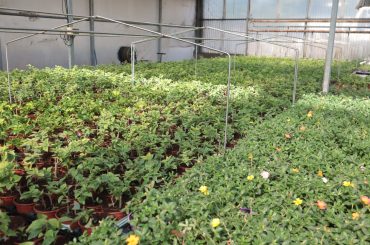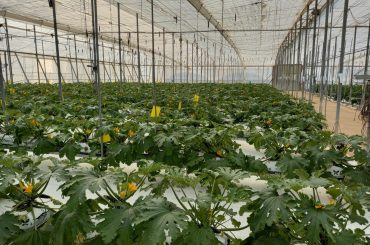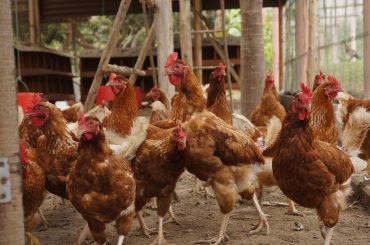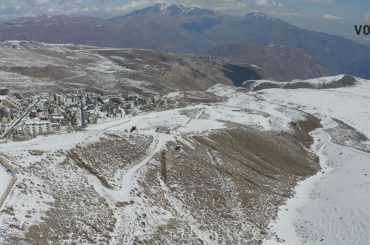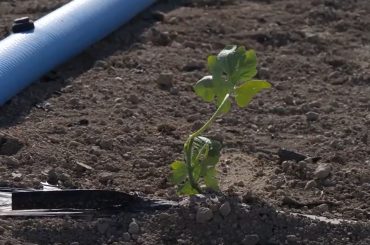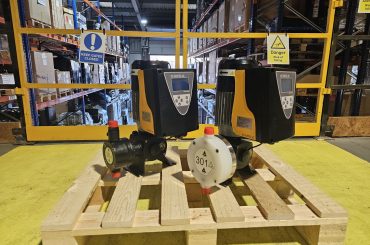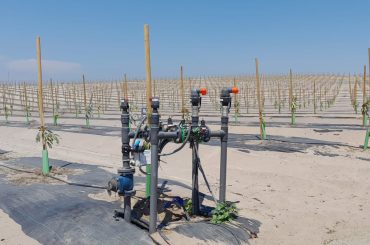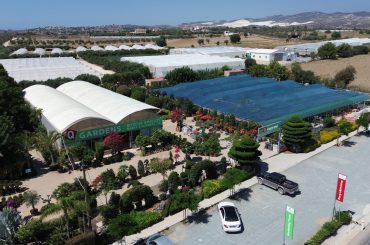Agricultural operations in Almería with venturi-type equipment facilities on farms with large irrigation flows where the use of concentrated fertilisers and dosage accuracy are of great importance in the operation’s results.
Courgette Cultivation in Almería
Context

The farm is irrigated from a pond with a mixture of well water and rainwater collected from run-off from the roofs. The well water contains a large amount of salts (1701 mg/l, EC=2.51mS), among which useful nutrients for the crop have been identified (287 mg/l N, 94 mg/l CaO, 76 mg/l MgO…), which can be deducted from the fertigation. The balance of nutrients in the well water does not match the balance required by the crop, so dosage has to be complemented differently depending on the rain/well ratio.
Salinity, just like the concentration of nutrients in the pond water, can vary from day to day, requiring equipment where the instructions can easily be changed, both in the concentration of the stock solution in irrigation and the composition of the stock solution.
The original equipment had 5 tanks in a shed, plus 2 large tanks in an extra warehouse, which occupied a significant part of the closed warehouses on the farm. Furthermore, locally made solutions were applied by dissolving soluble fertilisers in low concentrations with the aid of blower pumps.
One problem observed, surely due to a modification in the drip network, is that despite the fact that the centrifugal pump is oversized for the requested pumping, when the venturis act, they generate a pressure drop which prevents the water from reaching the farm’s highest altitudes. Thus it had been planned to replace this with a more powerful pump, which in turn would have caused greater electricity consumption.
The user measured the heights of the tanks, on occasion requesting the equipment to dose two of them evenly to ensure the accuracy of the dosage or to regulate the venturis’ flow.
Despite this, a “decalibration” of the equipment was very often observed, indicating that a different balance had been provided to the crop than that outlined by the technician responsible for fertilisation. The long distance to be covered by the fertilisers in the additional building might also have had an influence.
To adjust the pH, acid is dissolved in different proportions in the different tanks of stock solution fertiliser. However, as the amounts and proportions to be dosed between the two types of water vary, in addition to the concentration of bicarbonates and pH, the amount of acid supplied is based on the EC and the equipment cannot be responsible for reaching a certain pH.
- The amounts and proportions to dose between the two kinds of water vary, as do the concentration of bicarbonates and pH. Provide acid to reach a specific pH. Immediate adjustment of pH, EC.
- Precise traceability and control of the volumes and flows provided to irrigation are required.
- This is a farm with a Parral-type greenhouse dedicated to horticulture with a slope which results in load losses with non-technical systems in the highest altitudes of the farm.
- Preparing concentrated fertiliser solutions, saving space and optimising the use of resources.

ITC Solution
For one year, fertigation equipment different to the more popular venturis was tested in horticulture in Almeria. In August 2019, equipment was installed on a farm in Almerimar dedicated to horticulture, with a Parral-type greenhouse. The first crop after its implementation was courgette.
A traditional venturi machine was replaced by a piece of equipment with 5 advanced control dosing pumps managed by an ITC WATER CONTROLLER 3000 irrigation controller. The equipment has lived up to the farmer’s expectations, dosing precisely, reaching the default pH and EC values quickly, and maintaining them for the whole irrigation cycle.
The farm, which has 2.4 Ha under cultivation, is distributed in 5 greenhouses on land with a slight slope. The pond and pump house are in the centre, so some sectors are below the level of the pond, and others are above. In the 2019-2020 season, it was farmed using sanding and bags, with different types of droppers and sector dimensions, so stabilised water flows were 8 to 15 m3/h, but reaching peaks of up to 36 m3/h during the initial pipe filling.
Fertilisers were provided precisely through the irrigation water, through dosing pumps. The dosing pump allows the volumes and flows provided to the irrigation to be controlled, regardless of the fertiliser density or viscosity, the water pressure or speed at the injection point, or the height of the product in the tank of origin.
5 dosing systems were installed, which were managed as of the user’s default values, through independent analogue signals:
- 1,2,3 Fertilisers
- 4 Phosphoric acid
- 5 Nitric acid
The fertilisers are dosed through the ITC DOSTEC-AC dosing systems, with advanced control, in variable flow according to the EC and the ratio between them, or proportionally to the instantaneous irrigation flow, measured by a high-frequency flow meter. The control type and default value can be established for each individual sector and irrigation. These dosing systems can dose with precision from 1% to 100% of their capacity (QN 155 l/h), through their integrated frequency converter.
Pure acids are dosed directly to the container, without dissolving, through the ITC DOSITEC-MA dosing systems, at QN 6 l/h. The container is placed under the dosing system, introducing the foot valve with a filter that goes to the bottom of the container due to its weight. When one container has been used up, it is simply replaced with another.
The fertiliser pumps arrived at the farm already assembled on 1000-litre tanks equipped with agitation (turbine agitation).
An ITC WATER CONTROLLER 3000-6-24 controller was installed, allowing irrigation control (24 digital outputs for sectors, agitators, pond pump and well pump) and fertigation through one or more dosing systems through EC, pH and proportional dosage (“%”) default values. Each dosing system is controlled by independent analogue signals.
It can be programmed with a maximum of 50 irrigation programmes, and up to 15 daily repetitions (max. 750 irrigations/day), to which up to 48 fertigation programmes can be assigned, allowing different EC, pH or % default values depending on the sector or programme.
The equipment can manage up to 6 products independently (or more if they are dependent). The whole system is controlled remotely through the app or any internet browser (Chrome, Mozilla Firefox, Safari, Edge…). The user has all the equipment on their screen and can manage them easily.
Results
The farmer quickly became familiar with the irrigation and fertigation programming, and very soon started to manage the equipment by mobile phone, having complete mastery of the app functions. They also consulted the volumes applied and functioning through a browser.
The use of dosing systems makes it possible to continue irrigating with the pond pump, perfectly reaching the droppers at higher altitudes of the farm without having to substitute it or add a second Booster pump, as injection through the dosing system does not create load loss on the network.
The use of double concentrations of the stock solutions worked with initially was started, so the total stored volume was reduced, as well as the necessary frequency of preparing the stock solutions. This allowed the 2000-litre tanks to be removed from the additional warehouse, which is now used as a workshop and to store machinery.
The EC and pH default values were reached in a few seconds (approximately 5” with an accuracy of 0.2 points, and 5” more in the exact scope of 0.1 points), remaining stable throughout the whole irrigation cycle.
Without requiring regular calibrations, the volumes dosed were those anticipated, with the expected balance defined in the programmes. The equipment can apply very diluted solutions, as is traditional in Almería, or solutions close to saturation such as liquid fertilisers, being a suitable choice for transition or simultaneous use of both kinds of fertilisers. The range of action from 1 to 100% of the maximum flow, through a frequency converter, has made it possible to adapt, using the same products from sowing to peak demand.
The system offers historic data on individualised water and fertiliser use and parameters for each section and for any time period established by the user. The daily activity summary for each sector is always available to the user, just one click away on their mobile phone. This allows costs to be assigned to each unit served by a valve, which in this case coincides with the greenhouse unit.
The only maintenance operations carried out on the equipment were the regular calibration of the EC and pH sensor. The farmer has expressed their satisfaction with the use of the equipment.
Conclusions
Through several advanced control dosing pumps as of a WATER CONTROLLER 3000 programmer, the fertigation equipment is suitable for irrigation and fertilisation management in the customary crops in Almería, allowing a reduction in the volumes of fertilisers handled, volumetric accuracy in dosing and fast, stable EC and pH readings.
The intuitive use of the app and the option to obtain simple reports on water and fertiliser use facilitate farm management.
Location
- El Ejido, Almeria, Spain
Key Points
- Immediate adjustment of pH, EC.
- Accuracy and traceability of flow rates and volumes supplied.
- Farm with a Parral type greenhouse dedicated to horticulture.
- Installation of dosing pumps, controllers, sensors, communication elements and platform with management and traceability tools for the preparation of fertiliser solutions.
Used equipment
- DOSTEC AC 600 l/h: advanced control diaphragm dosing pump.

- Water Controller 3000: fertigation control equipment.

- Cloud Manager: APP for control and monitoring the ITC system

- Turbine Mixers







